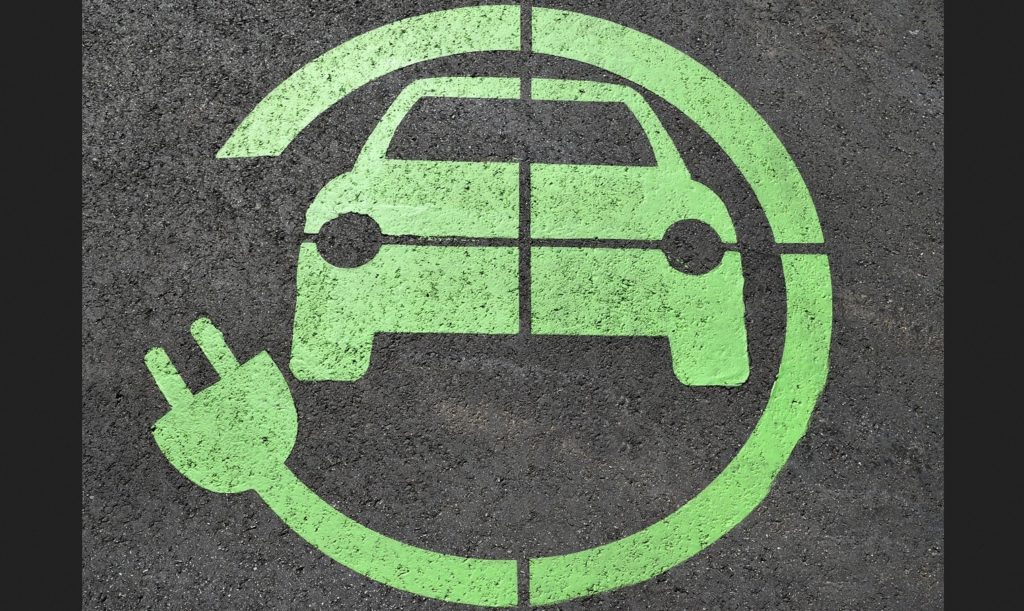 By B.N. Frank
By B.N. Frank
Electric vehicles (EVs) have many proponents including the Biden administration which continues to fund their manufacturing, maintenance, and operation in the U.S. Nevertheless, EVs – including bikes – have a serious battery fire problem that doesn’t seem to be going away (see 1, 2, 3, 4, 5, 6, 7, 8, 9, 10, 11, 12, 13). This being the case, it’s reasonable to assume that bigger EVs with bigger heavier batteries could cause bigger fires that could be more difficult to extinguish and we should all be concerned about that in addition to other oversized EV safety risks.
From Ars Technica:
EVs are getting too heavy and too powerful, safety chief says
NTSB chief warns that heavier vehicles mean more severe injuries and deaths.
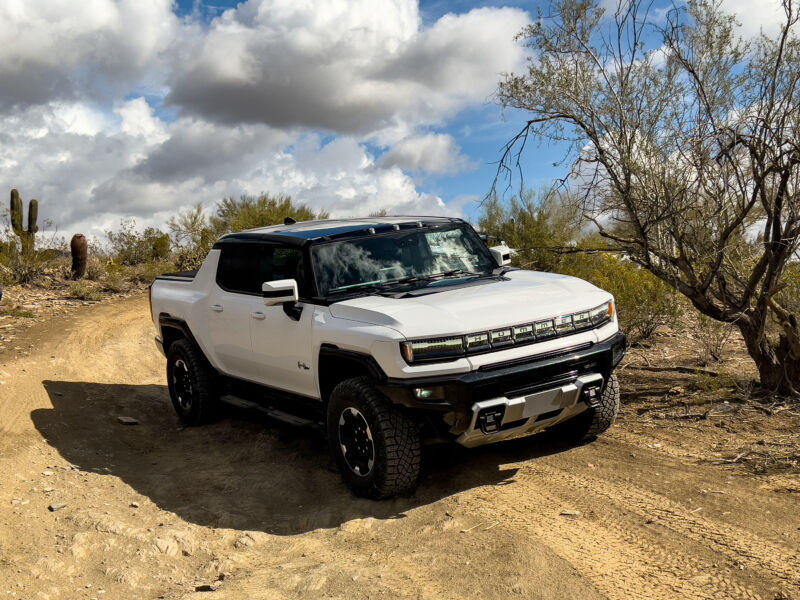 The Hummer EV has become the poster child for oversized, overweight EVs, and it was called out by the government’s top road safety advisor. Credit: Jonathan M. Gitlin
The Hummer EV has become the poster child for oversized, overweight EVs, and it was called out by the government’s top road safety advisor. Credit: Jonathan M. Gitlin
If you’re concerned that road vehicles are getting too large and too heavy, particularly as we make the transition to electric ones, you’re not alone. On Wednesday, National Transportation Safety Board chair Jennifer Homendy raised the alarm during her keynote speech at this year’s Transportation Research Board’s annual meeting in Washington, DC.
“I’m concerned about the increased risk of severe injury and death for all road users from heavier curb weights and [the] increasing size, power, and performance of vehicles on our roads, including electric vehicles,” she told attendees.
The poster child for excessive EVs is the GMC Hummer EV, a monster truck with a monstrous 9,063 lb (4,110 kg) curb weight. The vehicle is still powerful enough to hurl itself to 60 mph in three seconds. Appropriately, that feature is called “WTF mode.” Indeed, Homendy drew attention to the gigantic Hummer in her speech.
“Its gross vehicle weight rating is a staggering 10,550 lbs. The battery pack alone weighs over 2,900 lbs—about the weight of a Honda Civic. The Ford F-150 Lightning is between 2,000 and 3,000 lbs heavier than the non-electric version… That has a significant impact on safety for all road users,” Homendy continued.
The problem is one of simple physics: All else being equal, a heavier vehicle imparts more energy during a crash than a lighter one. Speed matters, too, of course—small increases become big increases in kinetic energy during a crash. But while municipalities and states set speed limits, there isn’t a similar restriction on passenger vehicle curb weights.
An F-150, a 3 Series, and a mini drive into a bar
To help visualize the problem, it’s useful to look at some examples of our vehicles gaining mass over time. Consider, for example, America’s bestseller, the Ford F-150 pickup truck. It comes in myriad combinations of powertrain, cabin, and powertrain, but let’s look at examples that are closest to today’s F-150 Lightning, Ford’s excellent EV pickup. Where a spread of curb weights was given, I erred on the side of caution and selected the heaviest one.
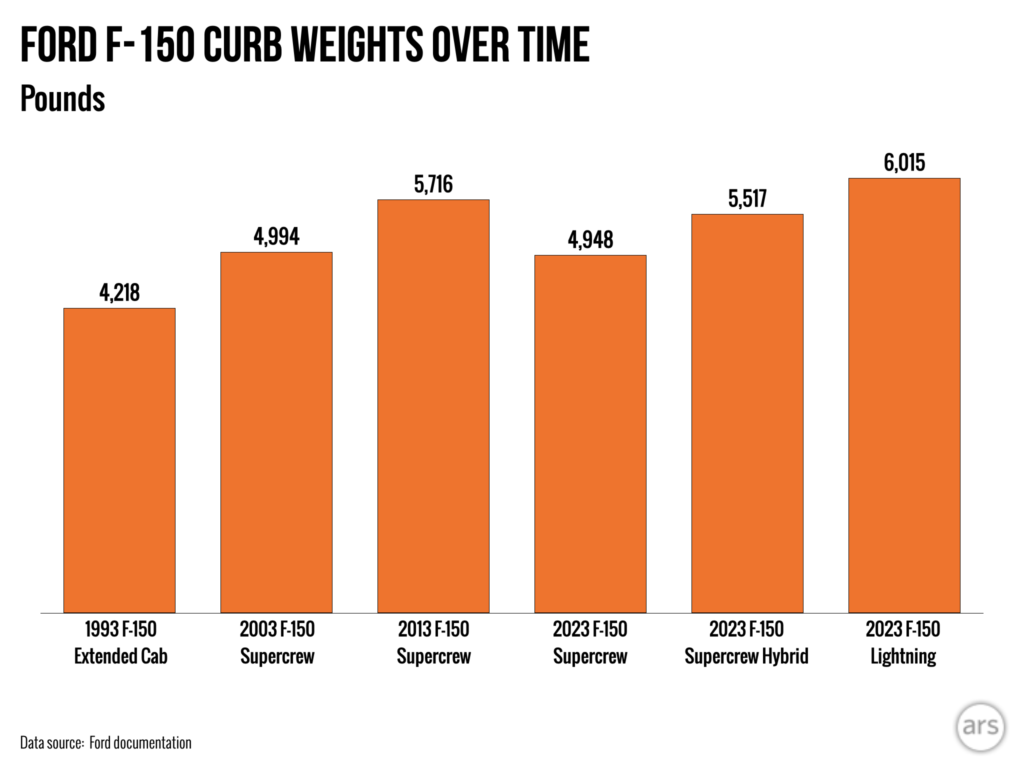 A graph showing the increase in Ford F-150 vehicle curb weight over time. Credit: Eric Bangeman
A graph showing the increase in Ford F-150 vehicle curb weight over time. Credit: Eric Bangeman
As you can see, in 1993, an extended cab F-150 was just under 2 metric tons, at 4,218 lbs (1,913 kg). A decade later—and now with a slightly larger Supercrew configuration—this number had gone up by 18 percent, and by 2013, a similar truck was 35 percent heavier than two decades prior.
In fact, Ford put the truck on a bit of a diet for the current generation; a gasoline-powered 2023 F-150 Supercrew weighs 4,948 lbs (2,244 kg). But the pounds pile back on if you want a hybrid F-150 or the all-electric version.
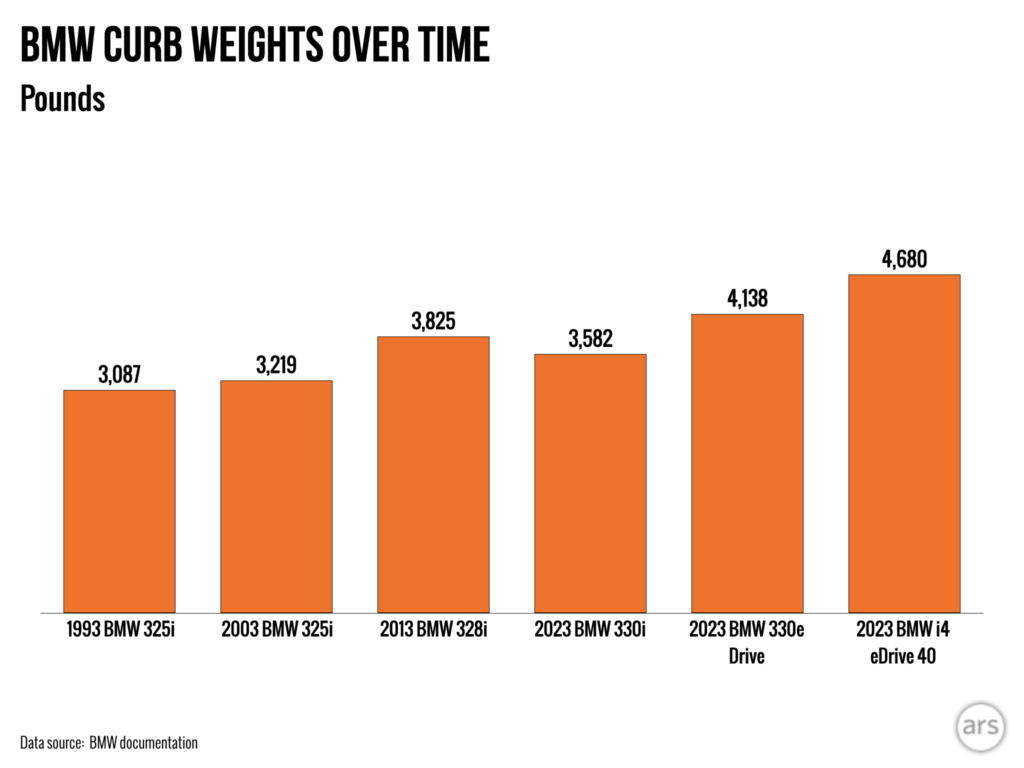 A graph showing the increase in BMW 3 Series vehicle curb weight over time. Credit: Eric Bangeman
A graph showing the increase in BMW 3 Series vehicle curb weight over time. Credit: Eric Bangeman
This problem is not limited to pickup trucks. We can see the same trend with BMW’s 3 Series, which grew a bit between 1993 and 2003, then quite significantly by 2013. Some of that mass had been shed for 2023, at least until you move to a plug-in hybrid or a battery EV powertrain.
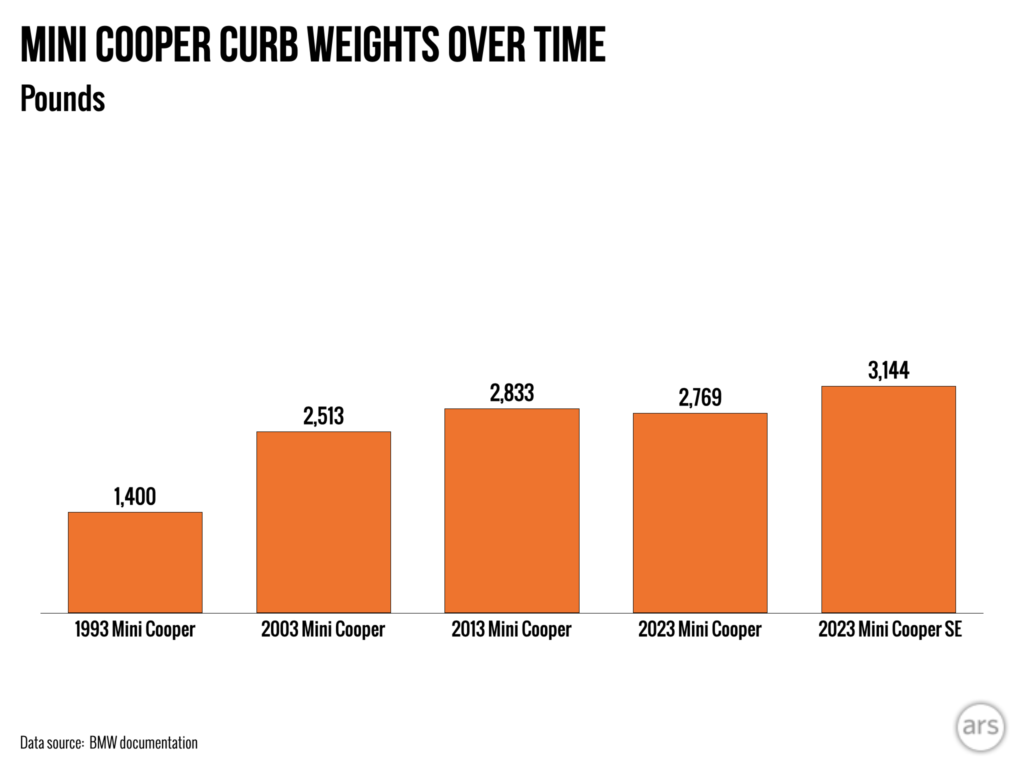 A graph showing the increase in Mini Cooper curb weight over time. Credit: Eric Bangeman
A graph showing the increase in Mini Cooper curb weight over time. Credit: Eric Bangeman
And the same holds true even for the smallest cars on our roads, like the Mini. To the untrained eye, a 1993 example looks pretty much the same as one of the 1961 originals, and its 1,400 lb (635 kg) curb weight now seems inconceivable. The Mini was reborn in the 21st century, but in 2003, it still weighed just 2,513 lbs (1,140 kg). That increased a bit over the following 10 years, then a slight diet followed by the time we get to 2023. But the electric version, at 3,144 lbs (1,426), is getting to be quite maxi for a mini.
Power keeps going up, but so does efficiency
At the end of last year, the US Environmental Protection Agency also noted the same trends that Homendy called out in her TRB keynote. The EPA’s data, which averages out all vehicles on sale, shows a steady increase in vehicle mass from the mid-1980s until 2000, at which point the rate of increase drops to about four percent per year. (That followed a five-year period from 1975 to 1980 when new cars got much lighter.)
But as Homendy pointed out, horsepower keeps going up, too, at a nearly linear rate since about 1982. The EPA says that since 2004, vehicle power has increased by 20 percent. And again, the faster a vehicle is traveling, the greater the energy that’s transferred in a crash.
Happily, the EPA also points out that real-world fuel efficiency has also increased over the same time period, and to an even greater degree—35 percent since 2004.
Does the I in IIHS stand for “irony”?
Ironically, safety systems are responsible for much (but by no means all) of the increased mass of new vehicles over time. Crash tests, such as those carried out by the National Highway Safety Administration or the Insurance Institute for Highway Safety, have changed over time. They are now conducted at higher speeds and at angles that have required automakers to increase protection for front-seat passengers and drivers. Airbags and energy-absorbing crash structures have made the occupants of vehicles much safer, but pedestrians and other vulnerable road users are paying the price, particularly as consumers move to larger SUVs and trucks over the smaller sedans of the past.
Unfortunately, the shift to EVs is exacerbating the problem. To offset the long charging times of an EV versus the rapid refueling of a car powered by liquid hydrocarbons, automakers are cramming massive batteries into their EVs—the assumption is that you have to offer at least 300 miles (483 km) of range to get people to part with their money. In 2021, Cox Automotive found that potential EV buyers wanted at least 341 miles (549 km) from a new EV, even if the average EV had a range of 257 miles (414 km).
When you combine that with America’s appetite for unaerodynamic pickups, the result is enormous battery packs. An extended-range F-150 Lightning needs 131 kWh to hit 300 miles, and the Hummer EV increases that to 212 kWh—enough to build more than six electric Mini batteries.
I’m hopeful we’ll see EV weights begin to decline, just as other vehicle curb weights dropped between 2013 and 2023. As I often point out, most people don’t drive too far each day, and heavy investment in fast-charging infrastructure along highways should, over time, ameliorate range anxiety. What’s more, should solid-state batteries prove viable for road cars, their much higher energy density compared to lithium-ion chemistries should also help to spur a reduction in mass. That’s the hope, at least.
Of course, there are numerous other issues associated with EVs including:
- Charging them threatens power grids (see 1, 2, 3, 4, 5) and medical implants
- Batteries are difficult and expensive to recycle
- Cold weather reduces battery performance
- Mining for battery ingredients IS NOT eco-friendly (see 1, 2, 3, 4)
- EVs emit high levels of biologically and environmentally harmful electromagnetic and wireless radiation (see 1, 2, 3, 4, 5, 6, 7). Got pets? Exposure can hurt them
Activist Post reports regularly about EVs and other unsafe technologies. For more information, visit our archives and the following websites:
- Wireless Information Network
- Electromagnetic Radiation Safety
- Environmental Health Trust
- Physicians for Safe Technology
Top image: Pixabay
Become a Patron!
Or support us at SubscribeStar
Donate cryptocurrency HERE
Subscribe to Activist Post for truth, peace, and freedom news. Follow us on SoMee, Telegram, HIVE, Flote, Minds, MeWe, Twitter, Gab, What Really Happened and GETTR.
Provide, Protect and Profit from what’s coming! Get a free issue of Counter Markets today.


Be the first to comment on "Nat’l Safety Chief Concerned about Increased Risks Associated with Oversized Electric Vehicles with 2000-3000 lb. Battery Packs"